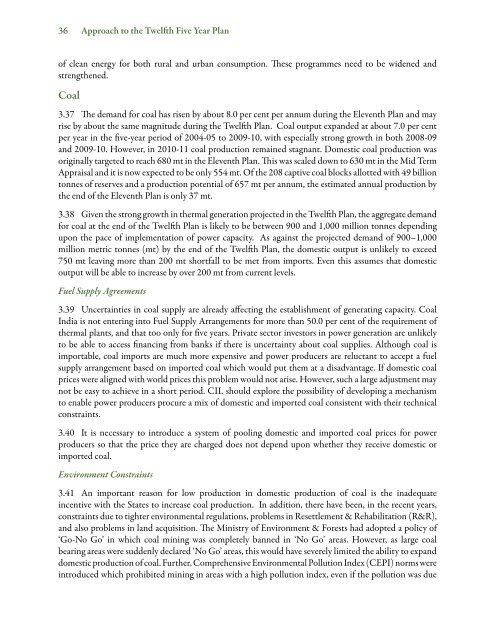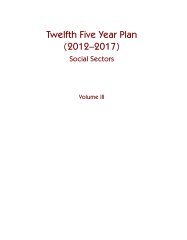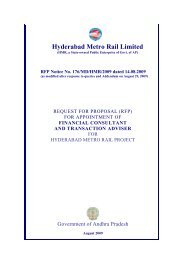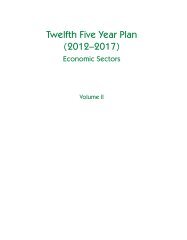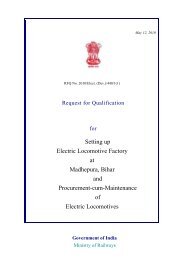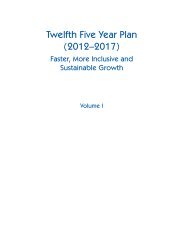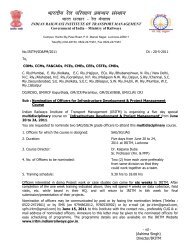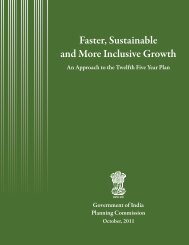Approach 12 FYP - Indian Railways Institute of Transport Management
Approach 12 FYP - Indian Railways Institute of Transport Management
Approach 12 FYP - Indian Railways Institute of Transport Management
You also want an ePaper? Increase the reach of your titles
YUMPU automatically turns print PDFs into web optimized ePapers that Google loves.
36 <strong>Approach</strong> to the Twelfth Five Year Plan<br />
<strong>of</strong> clean energy for both rural and urban consumption. These programmes need to be widened and<br />
strengthened.<br />
Coal<br />
3.37 The demand for coal has risen by about 8.0 per cent per annum during the Eleventh Plan and may<br />
rise by about the same magnitude during the Twelfth Plan. Coal output expanded at about 7.0 per cent<br />
per year in the five-year period <strong>of</strong> 2004-05 to 2009-10, with especially strong growth in both 2008-09<br />
and 2009-10. However, in 2010-11 coal production remained stagnant. Domestic coal production was<br />
originally targeted to reach 680 mt in the Eleventh Plan. This was scaled down to 630 mt in the Mid Term<br />
Appraisal and it is now expected to be only 554 mt. Of the 208 captive coal blocks allotted with 49 billion<br />
tonnes <strong>of</strong> reserves and a production potential <strong>of</strong> 657 mt per annum, the estimated annual production by<br />
the end <strong>of</strong> the Eleventh Plan is only 37 mt.<br />
3.38 Given the strong growth in thermal generation projected in the Twelfth Plan, the aggregate demand<br />
for coal at the end <strong>of</strong> the Twelfth Plan is likely to be between 900 and 1,000 million tonnes depending<br />
upon the pace <strong>of</strong> implementation <strong>of</strong> power capacity. As against the projected demand <strong>of</strong> 900–1,000<br />
million metric tonnes (mt) by the end <strong>of</strong> the Twelfth Plan, the domestic output is unlikely to exceed<br />
750 mt leaving more than 200 mt shortfall to be met from imports. Even this assumes that domestic<br />
output will be able to increase by over 200 mt from current levels.<br />
Fuel Supply Agreements<br />
3.39 Uncertainties in coal supply are already affecting the establishment <strong>of</strong> generating capacity. Coal<br />
India is not entering into Fuel Supply Arrangements for more than 50.0 per cent <strong>of</strong> the requirement <strong>of</strong><br />
thermal plants, and that too only for five years. Private sector investors in power generation are unlikely<br />
to be able to access financing from banks if there is uncertainty about coal supplies. Although coal is<br />
importable, coal imports are much more expensive and power producers are reluctant to accept a fuel<br />
supply arrangement based on imported coal which would put them at a disadvantage. If domestic coal<br />
prices were aligned with world prices this problem would not arise. However, such a large adjustment may<br />
not be easy to achieve in a short period. CIL should explore the possibility <strong>of</strong> developing a mechanism<br />
to enable power producers procure a mix <strong>of</strong> domestic and imported coal consistent with their technical<br />
constraints.<br />
3.40 It is necessary to introduce a system <strong>of</strong> pooling domestic and imported coal prices for power<br />
producers so that the price they are charged does not depend upon whether they receive domestic or<br />
imported coal.<br />
Environment Constraints<br />
3.41 An important reason for low production in domestic production <strong>of</strong> coal is the inadequate<br />
incentive with the States to increase coal production. In addition, there have been, in the recent years,<br />
constraints due to tighter environmental regulations, problems in Resettlement & Rehabilitation (R&R),<br />
and also problems in land acquisition. The Ministry <strong>of</strong> Environment & Forests had adopted a policy <strong>of</strong><br />
‘Go-No Go’ in which coal mining was completely banned in ‘No Go’ areas. However, as large coal<br />
bearing areas were suddenly declared ‘No Go’ areas, this would have severely limited the ability to expand<br />
domestic production <strong>of</strong> coal. Further, Comprehensive Environmental Pollution Index (CEPI) norms were<br />
introduced which prohibited mining in areas with a high pollution index, even if the pollution was due


